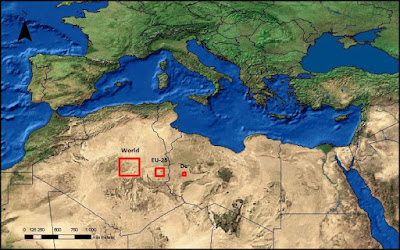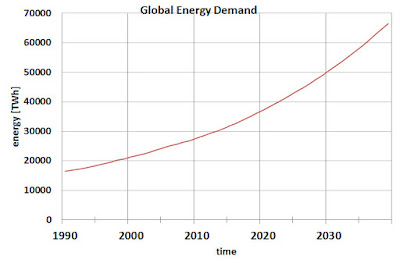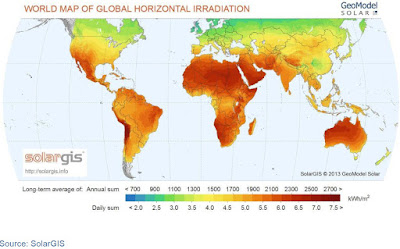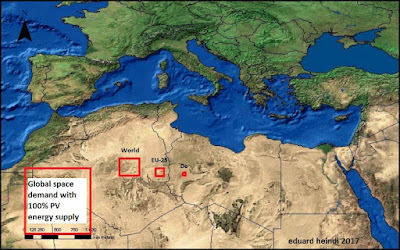Land demand for solar power
Solar energy for Germany, Europe, and the world
There is a picture in the solar scene (picture 1) that probably almost everyone knows, it shows how large the surface area is when the world is switched to solar energy. It was, as far as I know, published by Mrs. Nadine May for the first time in her diploma thesis at DLR [1]: |
| Figure 1: Space requirements for solar power plants, according to Nadine May [1] |
The squares have an edge length of: world 254 km, Europe 110 km and Germany only 45 km.
How big is the energy consumption in the world?
The energy consumption of the world is constantly growing (see figure 2), so it is difficult to specify the energy requirement without a reference year. Currently, the demand is over 30,000 TWh (30,000,000,000,000,000 kWh) using the further processed data from the International Energy Agency (IEA). I have considered transforming factors for certain energy forms (transportation, heating) into electricity. |
| Figure 2: Global energy demand for electricity, transport and all other forms of demand |
This energy should be converted with solar cells (PV) into electricity. There are several factors to consider, the efficiency, the irradiation during a year and the necessary storage of the energy for the night.
Solar cells made of silicon achieve an efficiency of around 20% and are currently the most economical method to generate large amounts of solar energy.
The irradiation is very different in different regions of the earth, in particular, one must always distinguish between direct and global irradiation. For photovoltaics (PV) only the global irradiation plays a role. Therefore, only this radiation is considered.
 |
| Figure 3: Global radiation perpendicular to the ground (source: WEC [2]) |
Necessary Land Area
The necessary areas of the solar cells can now be easily calculated. For the world, we need 30,000,000,000,000,000 kWh per year, since one square meter has an incidence of 2000 kWh which would theoretically be 15,000,000,000 m² or 15,000 km².Now the efficiency comes into play since only 20% is converted into electricity, we need the fivefold area, that is 75,000 km². However, one has to be able to build the cells and needs paths and additional areas for inverters and storage, which should double the space requirement. This is 150,000 km².
The transport and storage of energy, which is absolutely necessary, since at night the sun doesn't shine, will consume another 25% of the energy, so we are at 200,000 km².
This corresponds to a square of 448 km of edge length, roughly twice as large as in the drawing.
Fair World
Currently, only a few people consume a lot of energy and lots of people have little energy. I am convinced that in the long term all people want at least to reach the standard of living as in Germany. For this, an energy quantity of 15,000 kWh per year and per person would be necessary. There are some countries that already have a much higher energy requirement, but we hope that energy efficiency will also save some energy.With a world population of 8 billion people, this will yield an annual energy demand of 120,000 TWh or 120,000,000,000,000,000 kWh, or four times the current demand. This would increase the area with solar cells to a square with an edge length of 1000 km (Fig. 4).
 |
| Figure 4: Supply the world completely with solar energy in the future |
Storage requirements
If it is assumed that the energy must be stored for at least one day, this requires a storage capacity of 330 TWh (330,000 GWh)Compared: Germany has pumped storage with a capacity of 0.04 TWh.
If large Gravity Storage systems with 80 GWh capacity (500 m diameter) solves the problem, a considerable number of 4000 pieces would have to be built.
Using batteries from Elon Musk's Gigafactory, the Gigafactory produces at a planned capacity 50 GWh per year; over 6000 years of production or 400 Gigafactories for 15 years are required. This is to provide the capacity for the first time, and we have to continue production because batteries must be replaced after 15 years.
Gigantic conversion
If the global conversion to solar energy succeeds, huge buildings in the form of gigantic solar fields will be necessary. Surely the roof surfaces are never enough. Furthermore, investments are in the order of magnitude of the global gross social product of one year ($80,000 billion). This sounds a lot, but it will help mankind to be sustainable. Especially when one considers that afterward energy is produced clean, without CO2 and at a low cost.I think: we can do it!
Sources:
[1] Eco-balance of a Solar ElectricityTransmission from North Africa to Europe, Diploma Thesis of Nadine May, Braunschweig, May 2005[2] World Energy Resources Solar 2016, World Energy Council 2017
A 186 page paper going into details is from Jakobson et.al., 100% Clean and Renewable Wind, Water, and Sunlight (WWS) AllSector Energy Roadmaps for 139 Countries of the World